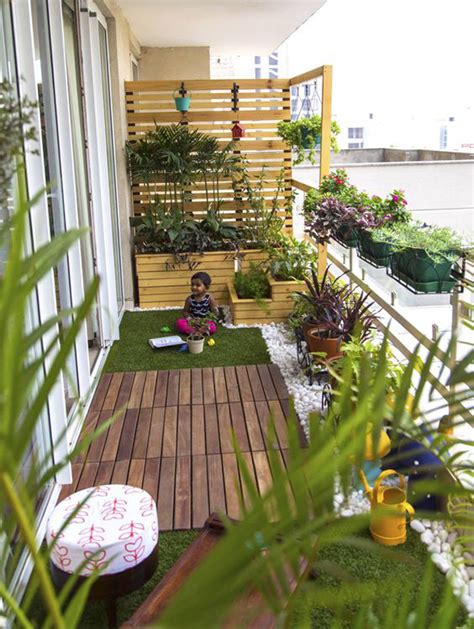Creating a Child-Friendly Balcony Garden: Urban Gardening for the Whole Family
Urban gardening has gained popularity, offering a green oasis even in small spaces like balconies. Designing a child-friendly balcony garden is an opportunity to nurture a family-friendly environment while instilling a love for nature in children. However, creating a garden that’s safe, engaging, and educational for children requires careful planning and execution. In this guide, we’ll explore how to design a child-friendly balcony garden that promotes safety, learning, and fun, while making the most out of limited space.
Key Concepts in Child-Friendly Balcony Garden Design
- Safety First: Ensuring the balcony is childproof, with secure railings and no sharp or hazardous objects.
- Engagement and Learning: Introducing plants and activities that stimulate curiosity and responsibility.
- Practicality: Selecting plants and materials that are easy to manage and resilient to children’s handling.
- Creativity: Allowing space for imagination through colorful plants, fun containers, and garden-related crafts.
Historical Context of Balcony Gardens
Balcony gardens have been an integral part of urban spaces for centuries. In the ancient Mediterranean, for instance, balconies were used to cultivate herbs and medicinal plants. Over time, the idea of gardening in limited spaces has evolved, with modern techniques like container gardening and vertical gardening making it easier to create lush green environments in the smallest areas. In recent years, there has been a growing interest in urban gardening as families look for sustainable and educational activities that they can enjoy together.
Current State of Balcony Gardening for Families
Today, more families are embracing balcony gardening as part of family activities. From growing vegetables in small spaces to involving children in the process, balcony gardens serve as both recreational and educational spaces. In densely populated urban environments, they offer a vital connection to nature, especially for children who may not have access to traditional gardens.
Practical Applications for Creating a Child-Friendly Balcony Garden
When designing a child-friendly balcony garden, practicality is key. Here are some strategies to implement:
- Container Selection: Use lightweight, unbreakable containers with smooth edges. Opt for colorful or playful designs that will appeal to children.
- Plant Choices: Choose non-toxic, fast-growing plants like sunflowers, cherry tomatoes, and herbs, which offer immediate gratification and are safe for children.
- Interactive Elements: Incorporate raised beds or small toolkits to allow children to plant and water their own section of the garden.
- Educational Plants: Consider plants that teach children about biology and ecology. For example, sunflowers demonstrate phototropism, while legumes like beans illustrate the nitrogen cycle.
Case Studies in Child-Friendly Balcony Garden Projects
Let’s examine a few examples of successful child-friendly balcony gardens:
| Location | Design Features | Child Engagement |
|---|---|---|
| New York City Apartment | Vertical garden with hanging pots, herbs, and sunflowers | Children helped water plants daily and measured growth weekly |
| London Flat | Small containers for veggies like cherry tomatoes and lettuce | Kids planted seeds and observed their germination process |
| Tokyo High-Rise | Creative use of recycled materials for containers | Children designed their own pots and labeled plants with fun names |
Stakeholder Analysis
- Parents: Looking for a safe, educational, and enjoyable activity for their children.
- Children: Interested in fun, hands-on activities that allow them to be creative and learn.
- Urban Planners: Encouraging green spaces in densely populated areas for both environmental and mental health benefits.
- Retailers: Offering child-friendly gardening kits, tools, and plants.
Implementation Guidelines for Child-Friendly Balcony Gardens
- Safety Measures: Install secure railing coverings to prevent falls, and keep all tools out of reach when not in use.
- Space Maximization: Use vertical garden techniques, such as trellises and wall-mounted planters, to make the most of limited space.
- Child Involvement: Create designated zones where children can take ownership of planting and watering tasks.
- Routine Maintenance: Ensure that plants selected are easy to maintain and can thrive in various light conditions commonly found on balconies.
- Seasonal Adaptation: Rotate plants based on the season to keep the garden dynamic and interesting for children.
Ethical Considerations in Balcony Gardening with Children
Ethical considerations include ensuring that the materials used in your garden are eco-friendly and sustainable. Additionally, be mindful of your local environment and use plants that support biodiversity rather than invasive species. It’s also important to teach children about the importance of water conservation and waste reduction in gardening practices.
Limitations and Future Research
While balcony gardening offers numerous benefits, there are limitations. Space constraints may restrict the variety of plants that can be grown, and not all plants thrive in the urban microclimates typical of balconies. Future research could explore the development of more resilient, child-friendly plant varieties and innovative container solutions that maximize vertical space. Another avenue for exploration is the psychological and developmental impacts of gardening on children in urban environments.
Expert Commentary on Child-Friendly Balcony Gardens
Experts agree that balcony gardening is more than just a hobby—it’s a valuable tool for child development. “Children who engage with plants and gardening develop a stronger connection to nature and a better understanding of where food comes from,” says Dr. Sarah Green, a child psychologist specializing in nature-based learning. Urban gardening enthusiasts, like John Rivera, highlight the practical benefits: “It’s a great way to get kids outdoors, even in the middle of a city. The garden becomes a mini science lab, art studio, and classroom all in one.”
With the right approach, a child-friendly balcony garden can provide hours of entertainment, learning, and bonding for the entire family.


